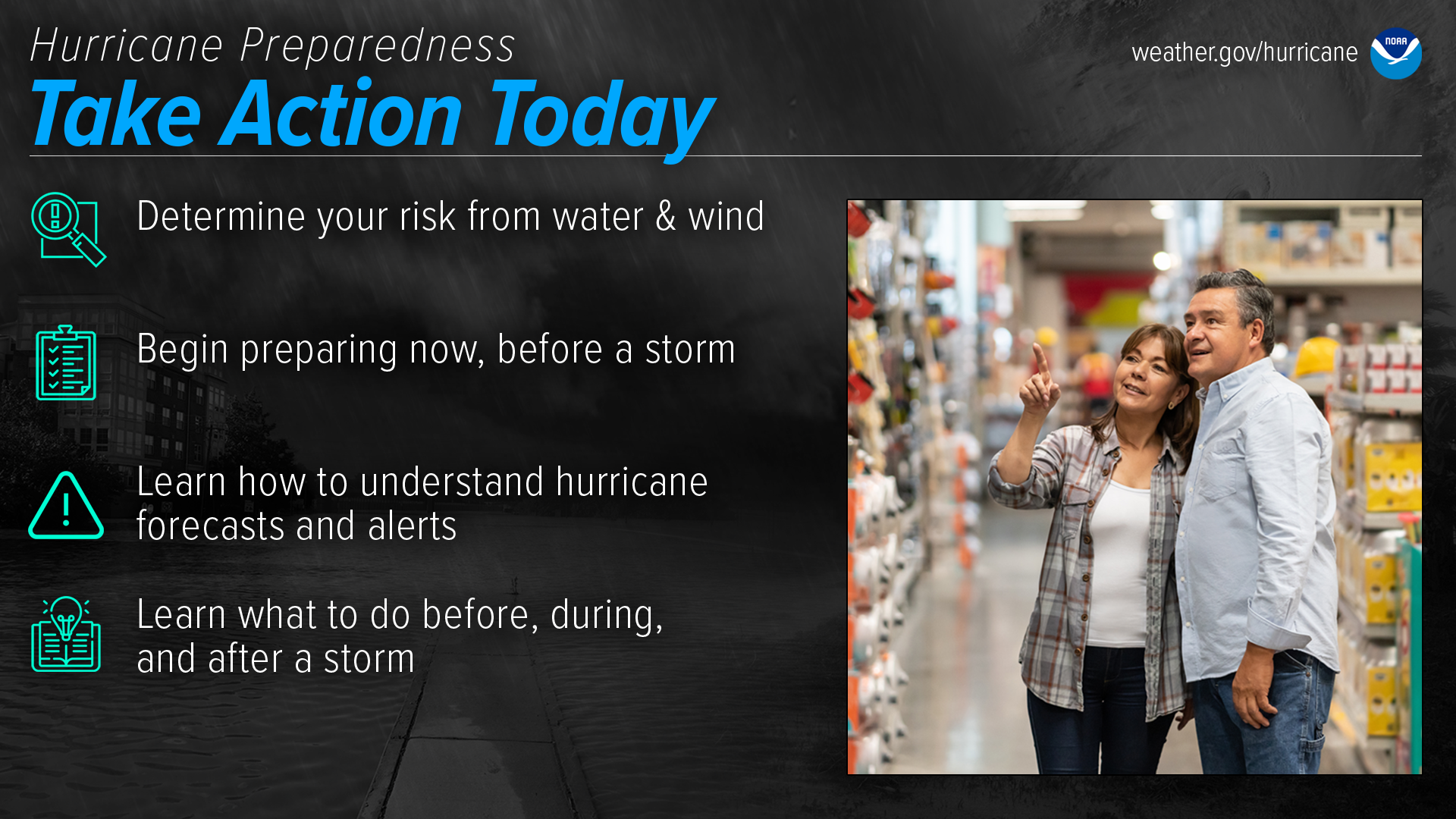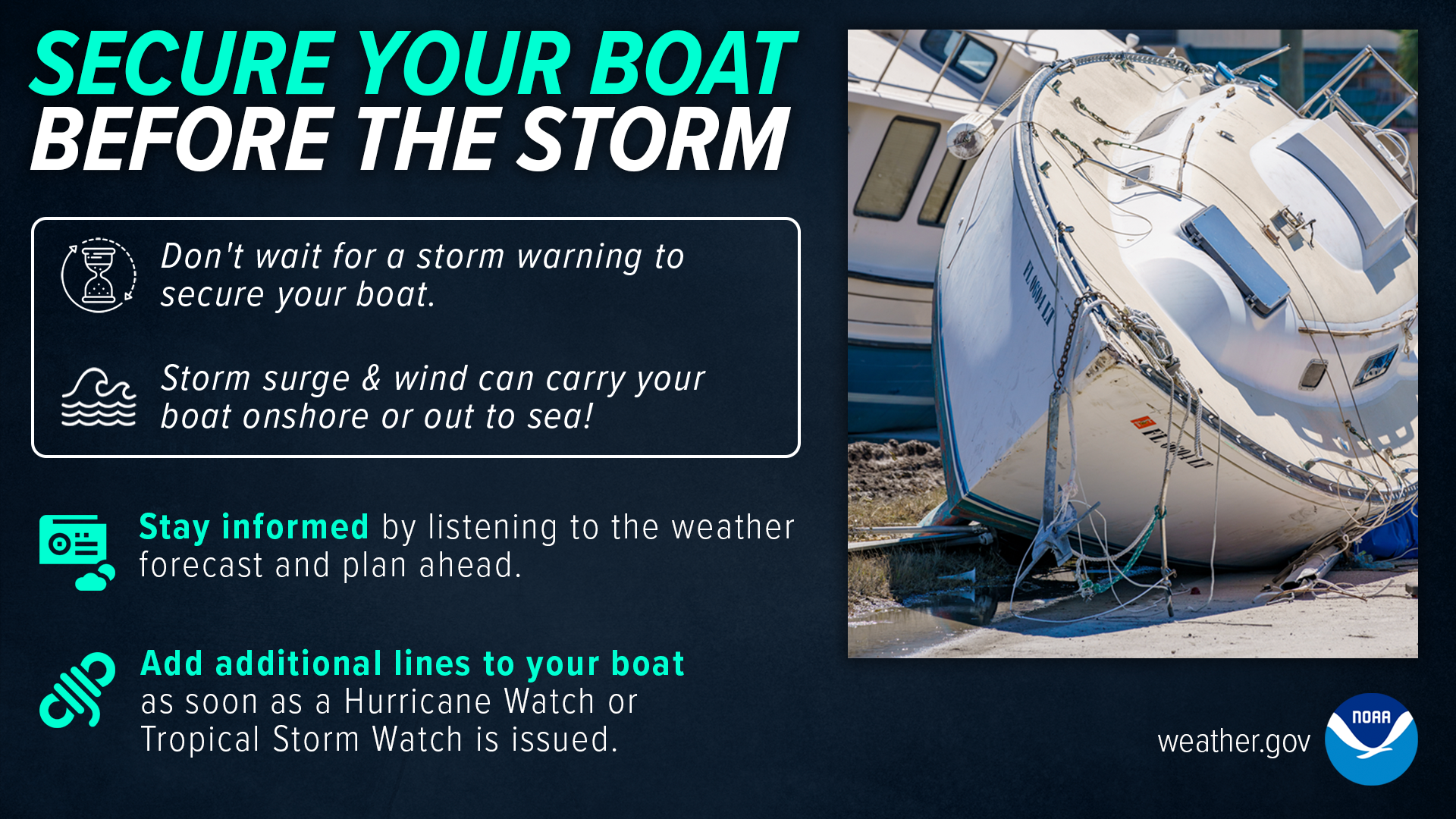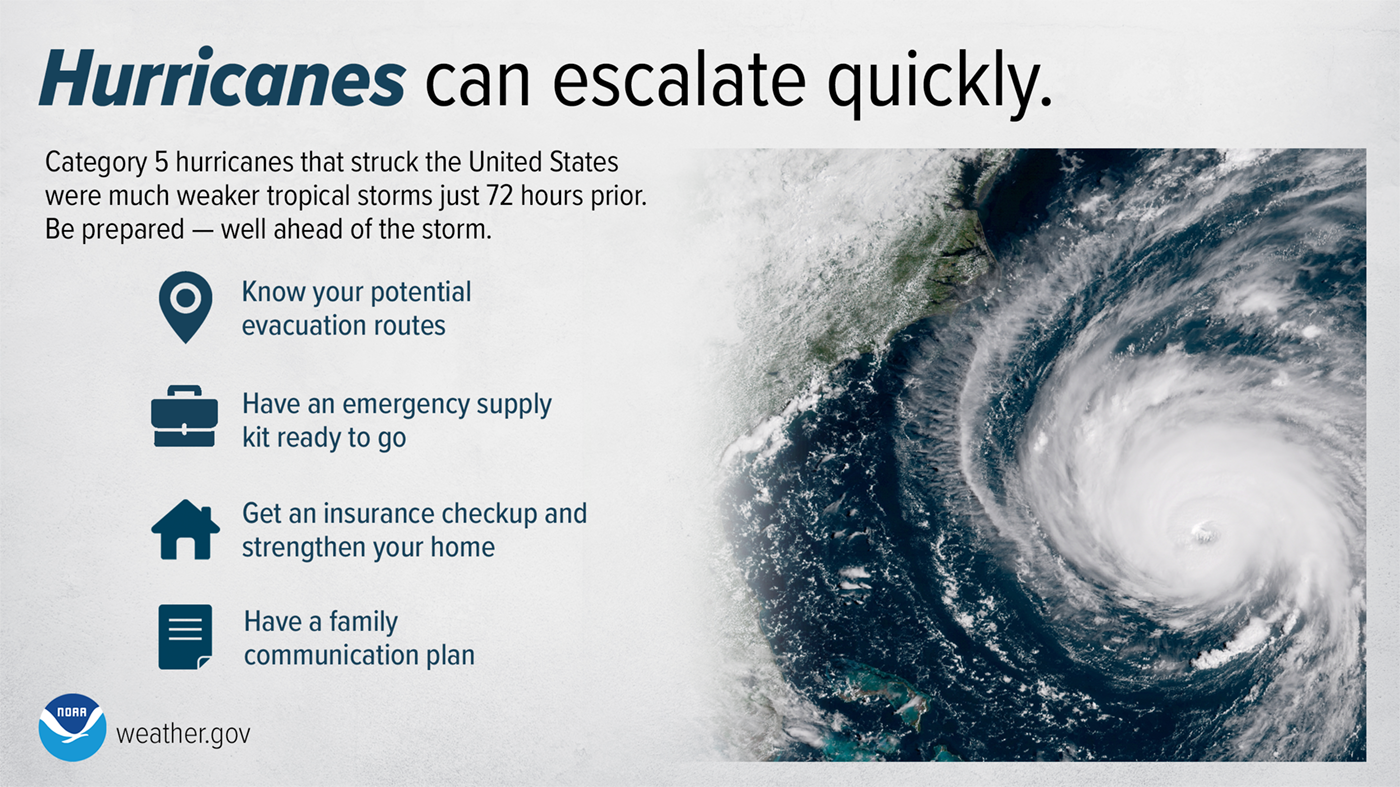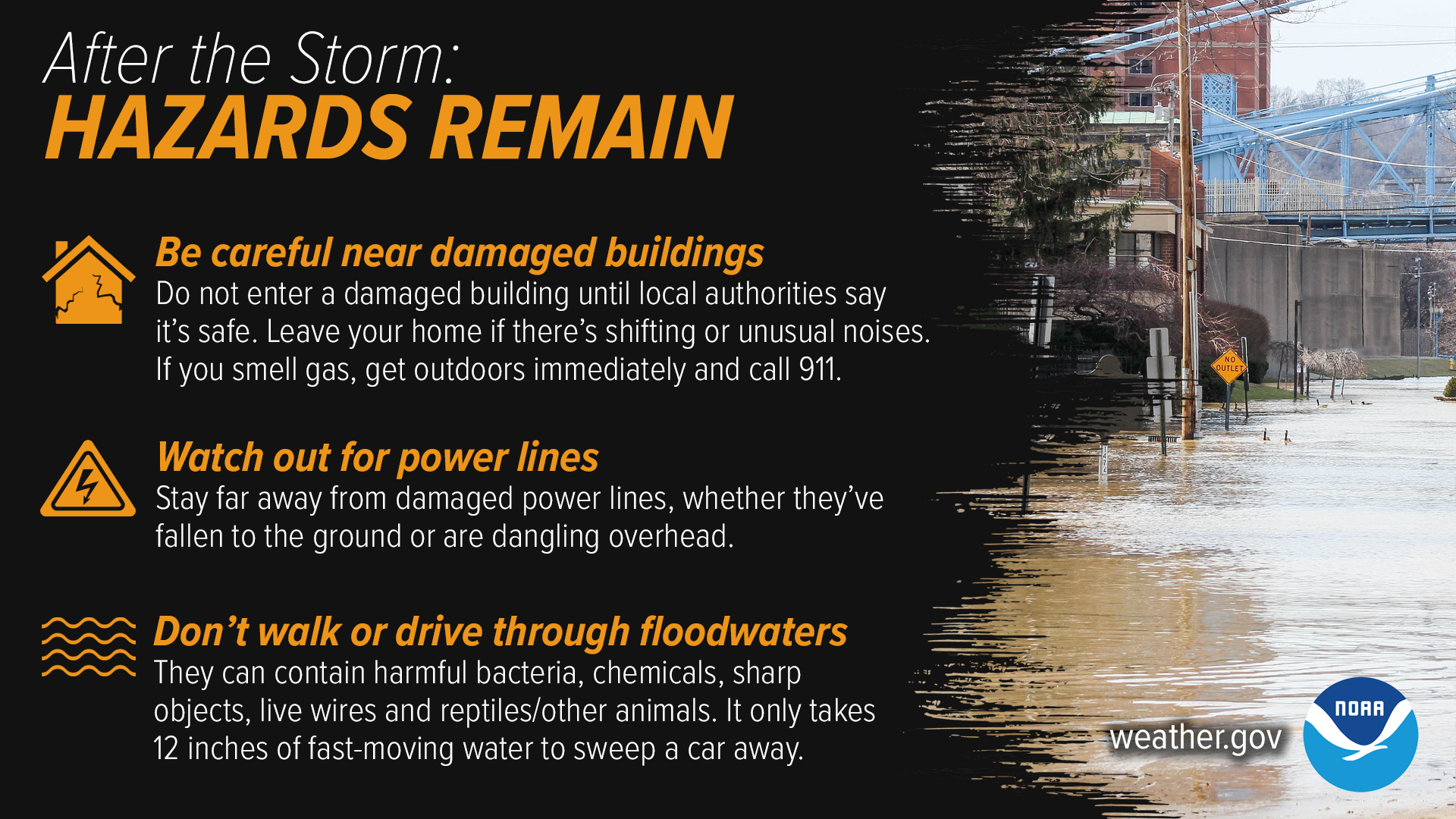Please help the National Weather Service spread these important safety messages on social media! Everyone is welcome to use the text and images provided below to help the NWS build a Weather-Ready Nation.
Facebook
Are you ready for hurricane season? Find out how you can prepare and remain Weather-Ready: weather.gov/wrn/hurricane-preparedness
Twitter
Are you ready for hurricane season? Find out how you can prepare and remain Weather-Ready: weather.gov/wrn/hurricane-preparedness

Facebook
The first step of preparing for hurricanes is to know your risk. Find out today what types of water and wind hazards could happen where you live. Hurricanes are not just a coastal problem. Impacts from wind and water can be felt hundreds of miles inland, and significant impacts can occur regardless of the storm’s strength. Know if you live in an area prone to flooding, if you live in an evacuation zone, and identify any structural weaknesses in your home. noaa.gov/know-your-risk-water-wind
Twitter
The first step of preparing for hurricanes is to know your risk. Hurricanes are not just a coastal problem, so find out today what types of water and wind hazards could happen where YOU live. #HurricanePrep #HurricaneStrong noaa.gov/know-your-risk-water-wind

Facebook
The best time to prepare for hurricanes is BEFORE hurricane season begins. Avoid having to rush through potentially life-saving preparations by waiting until it’s too late. Get your disaster supplies while the shelves are still stocked, and get that insurance checkup early, as flood insurance requires a 30-day waiting period. noaa.gov/prepare-before-hurricane-season
Twitter
The best time to prepare for hurricanes is BEFORE hurricane season begins. Avoid having to rush through potentially life-saving preparations by waiting until it’s too late. #HurricanePrep #HurricaneStrong noaa.gov/prepare-before-hurricane-season

Facebook
Prepare for hurricane season by knowing how to understand forecasts. They can tell you a lot about what is expected, including the storm’s paths, rainfall amounts, wind speeds, and more. There is a lot of information available days ahead of a storm, and it is important to understand what it means. noaa.gov/understand-forecast-information
Twitter
Prepare for hurricane season by knowing how to understand forecasts. They can tell you a lot about what is expected, including the storm’s path, rainfall amounts, wind speeds, and more. #HurricanePrep #HurricaneStrong noaa.gov/understand-forecast-information

Facebook
Do you know what to do when a storm threatens? Prepare for hurricane season by taking the time now to understand the actions needed when time is of the essence. noaa.gov/get-moving-when-storm-threatens
Twitter
Do you know what to do when a storm threatens? Prepare for hurricane season by taking the time now to understand the actions needed when time is of the essence. #HurricanePrep #HurricaneStrong noaa.gov/get-moving-when-storm-threatens

Facebook
Be prepared for hurricane season by knowing what to do during a storm. Whether you’ve evacuated or are sheltering in place, know what to expect from the hazards you may face. Remain vigilant, stay up-to-date with the latest forecasts and alerts, and continue to listen to local officials. noaa.gov/stay-protected-during-storms
Twitter
Be prepared for hurricane season by knowing what to do during a storm. Whether you’ve evacuated or are sheltering in place, know what to expect from the hazards you may face. #HurricanePrep #HurricaneStrong noaa.gov/stay-protected-during-storms

Facebook
A key part of hurricane preparedness is understanding the dangers that remain well after a storm. This is NOT the time to let your guard down. Nearly half of hurricane fatalities occur after the storm. noaa.gov/use-caution-after-storms
Twitter
A key part of hurricane preparedness is understanding the dangers that remain well after a storm. This is NOT the time to let your guard down. Nearly half of hurricane fatalities occur after the storm. #HurricanePrep #HurricaneStrong noaa.gov/use-caution-after-storms

Facebook
Are you ready for hurricane season? Take action TODAY to be better prepared for when the worst happens. Understand your risk from hurricanes, and begin pre-season preparations now. Make sure you understand how to interpret forecasts and alerts, and know what to do before, during, and after a storm. Even if you feel ready, there may be additional things you could do or learn. noaa.gov/take-action-today
Twitter
Are you ready for hurricane season? Take action TODAY to be better prepared for when the worst happens. Even if you feel ready, there may be additional things you could do or learn. #HurricanePrep #HurricaneStrong noaa.gov/take-action-today

Facebook
If you have pets, do you know what you would do with them during a hurricane? Prepare for the worst by assembling an animal emergency supply kit and developing a pet care buddy system. Be aware that not all shelters accept pets. Whether you decide to stay put in an emergency or evacuate to a safer location, you will need to make plans in advance for your pets. ready.gov/animals
Twitter
What would you do with your pets during a hurricane? Prepare for the worst by assembling an animal emergency supply kit and developing a pet care buddy system. Visit ready.gov/animals to make a plan. #HurricanePrep

Facebook
Don't wait for a Tropical Storm or Hurricane Warning to secure your boat. By then, it's too late to safely work on a dock. Listen to weather forecasts and plan ahead. Haul out your boat or add additional lines as soon as a tropical storm or hurricane watch is issued. This will typically give you 48 hours before the anticipated onset of tropical storm winds and will allow you to safely secure your boat. weather.gov/safety/safeboating-before
Twitter
Boaters: Check the forecast and secure your boat for a #hurricane BEFORE a warning is issued. weather.gov/safety/safeboating-before #HurricanePrep

Facebook
A tropical system does not have to reach hurricane strength to be deadly. Tropical storms can produce strong winds and tornadoes, as well as heavy rainfall, which can lead to flooding. Don’t let your guard down when there’s a tropical storm watch. For more information about tropical storms and hurricanes, visit weather.gov/safety/hurricane
Twitter
Hurricanes can be deadly, but so can tropical storms! weather.gov/safety/hurricane #WeatherReady

Facebook
Did you know that the Category 5 hurricanes that have struck the United States were much weaker tropical storms just 72 hours prior? Storms can intensify surprisingly quickly — stay Weather-Ready by being prepared well ahead of time. weather.gov/wrn/hurricane-preparedness
Twitter
Did you know that the Category 5 hurricanes that have struck the United States were much weaker tropical storms just 72 hours prior? Storms can intensify surprisingly quickly — stay #WeatherReady by being prepared well ahead of time. weather.gov/wrn/hurricane-preparedness

Facebook
A Hurricane WATCH is when hurricane force winds are POSSIBLE within 48 hours.
A Hurricane WARNING is when they are EXPECTED within 36 hours.
Know the difference and stay Weather-Ready! weather.gov/safety/hurricane-ww
Twitter
A Hurricane WATCH is when hurricane force winds are POSSIBLE within 48 hours.
A Hurricane WARNING is when they are EXPECTED within 36 hours.
Know the difference and stay #WeatherReady weather.gov/safety/hurricane-ww

Facebook
Some hurricane preparations, such as strengthening your home, can be significant efforts. But there are also small decisions that, if made, could save your life. Small decisions like keeping your gas tank full, looking up your evacuation zone, or having a long extension cord for your generator can end up making a big impact when the storm hits. weather.gov/safety/hurricane
Twitter
Some hurricane preparations, such as strengthening your home, can be significant efforts. But there are also small decisions that, if made, could save your life. weather.gov/safety/hurricane #WeatherReady

Facebook
Coastal flooding is defined as saltwater or freshwater inundation along the coast and can be caused by storm surge, onshore winds, high surf, or high astronomical tides. If coastal flooding is expected in your area, follow the advice of your local officials, and be prepared to evacuate. Do not drive through flooded roads and parking lots of unknown depth...what may look like a puddle could actually be a washed out road. weather.gov/safety/flood
Twitter
Coastal flooding is defined as inundation along the coast and can be caused by storm surge, onshore winds, high surf, or high astronomical tides. If coastal flooding is expected in your area, take action. weather.gov/safety/flood #WeatherReady

Facebook
Storm surge can cause major damage to your home and pose a significant threat for drownings - making it one of the greatest threats to life and property from a hurricane. Listen to local officials and evacuate immediately if told to do so. If you’re not in an evacuation zone, be sure to stay away from floodwaters and never drive through water-covered roads. Remember: Turn Around, Don’t Drown! weather.gov/safety/flood-turn-around-dont-drown
Twitter
Storm surge is often the greatest threat to life and property from a #hurricane. weather.gov/safety/flood-turn-around-dont-drown #WeatherReady

Facebook
Do you know the difference between a Storm Surge Warning and a Storm Surge Watch? A Storm Surge Warning means there is a danger of life-threatening flooding within the next 36 hours. A Storm Surge Watch means there is a possibility of life-threatening flooding within the next 48 hours. In either case, please promptly follow evacuation and other instructions from local officials. Visit weather.gov/hurricanesafety for more hurricane safety tips.
Twitter
Do you know the difference between a Storm Surge Warning and Watch? Visit weather.gov/hurricanesafety for more tips.

Facebook
Storm surge is the abnormal rise of water generated by a storm’s winds. This hazard is historically the leading cause of deaths in the United States during storms. The destructive power of storm surge and large battering waves can result in a large loss of life and destruction along the coast. Storm surge can travel several miles inland, especially along bays, rivers, and estuaries. Watch this video to learn about storm surge and how to stay safe! https://www.youtube.com/watch?v=bBa9bVYKLP0 #HurricanePrep #ItOnlyTakesOne
Twitter
Learn about storm surge and how to stay safe! https://www.youtube.com/watch?v=bBa9bVYKLP0 #HurricanePrep #ItOnlyTakesOne
Facebook
Take some time to make sure you have a hurricane evacuation plan. The first thing you need to do is find out if you live in a storm surge hurricane evacuation zone or if you’re in a home that would be unsafe during a hurricane. If you are, figure out where you’d go and how you’d get there if told to evacuate. You do not need to travel hundreds of miles. Identify someone, perhaps a friend or relative who doesn’t live in an evacuation zone or unsafe home, and coordinate with them to use their home as your evacuation destination. Be sure to account for your pets, as most local shelters do not permit them. Put the plan in writing for you and those you care about.
hurricanes.gov/prepare
Twitter
Are you in a hurricane evacuation zone or in a home that would be otherwise unsafe in a hurricane? If so, think now about where you’d go and how you’d get there if you're told to evacuate. hurricanes.gov/prepare #HurricanePrep #WeatherReady

Facebook
Just having enough supplies to make it through a hurricane isn’t enough. You need plenty to make it through what could be a LONG recovery period too. Water and electricity could be out for a week or more. Have enough non-perishable food, water, and medicine to last each person in your family for a MINIMUM of three days. Also make sure you have extra cash, a battery-powered radio, flashlights, and a portable crank or solar-powered USB charger to charge your cell phone. ready.gov/kit
Twitter
Just having enough supplies to make it through a hurricane isn’t enough. You need plenty to make it through what could be a long recovery period too. Prepare for AT LEAST three days. ready.gov/kit #HurricanePrep #WeatherReady

Facebook
Today, call your insurance company or agent and ask for an insurance checkup to make sure you have enough homeowners insurance to repair or even replace your home...and remember, standard homeowners insurance doesn’t cover flooding. Whether you’re a homeowner or renter, you’ll need a separate policy for flooding. floodsmart.gov. Act now, as flood insurance requires a 30-day waiting period.
Twitter
Are you insured for a hurricane? Keep in mind that standard homeowners insurance doesn’t cover flooding, and flood insurance requires a 30-day waiting period! Find coverage at floodsmart.gov #HurricanePrep #HurricaneStrong

Facebook
Many Americans rely on their neighbors after a disaster, but there are also many ways you can help your neighbors before a hurricane approaches. Learn about all the different actions your community can take to prepare and recover from the hazards associated with hurricanes: ready.gov/neighbors
Twitter
You can play a large role in how your neighbors fare before, during, and after a hurricane. ready.gov/neighbors #HurricanePrep #WeatherReady

Facebook
The time to prepare for a hurricane is NOW, before a storm is upon you. Once you’re under pressure, having a written plan will take the guesswork out of what you need to do to protect you and your family. Know where you will ride out the storm and get your supplies now. You don’t want to be standing in long lines when a Hurricane Watch is issued. Those supplies that you need will probably be sold out by the time you reach the front of the line. Being prepared now will mean the difference between being a hurricane victim and a hurricane survivor.
ready.gov/make-a-plan
Twitter
The time to prepare for a hurricane is NOW, before the season begins. Once you’re under pressure, having a written plan will take the guesswork out of what you need to do to protect you and your family. ready.gov/make-a-plan #HurricanePrep #WeatherReady

Facebook
Hurricane dangers remain ever after the skies turn blue. Watch out for downed power lines and damaged buildings. Avoid floodwaters as they can hide a variety of dangers, and never drive through them, as it doesn’t take much to sweep your car away.
weather.gov/safety/hurricane-after
Twitter
Hurricane dangers remain ever after the skies turn blue. Watch out for downed power lines and damaged buildings. Avoid floodwaters as they can hide a variety of dangers, and never drive through them, as it doesn’t take much to sweep your car away.
weather.gov/safety/hurricane-after

Facebook
Even after the storm passes, power outages have their own set of hazards. Be especially careful with generators — never use them inside or in garages to avoid carbon monoxide poisoning. Use flashlights, not candles, to avoid risk of fire. weather.gov/safety/hurricane-after
Twitter
Even after the storm passes, power outages have their own set of hazards. Be especially careful with generators — never use them inside or in garages to avoid carbon monoxide poisoning. Use flashlights, not candles, to avoid risk of fire. weather.gov/safety/hurricane-after

Facebook
Be careful when cleaning up after a hurricane. Cleanup slowly, taking lots of breaks to avoid straining your body. Be very careful with chainsaws and other power tools. Make sure to stay safe in the heat by staying hydrated, taking breaks in the shade or AC. weather.gov/safety/hurricane-after
Twitter
Be careful when cleaning up after a hurricane. Cleanup slowly, taking lots of breaks to avoid straining your body. Be very careful with chainsaws and other power tools. Make sure to stay safe in the heat by staying hydrated, taking breaks in the shade or AC. weather.gov/safety/hurricane-after

Facebook
Are you prepared for hurricane season? Find out how you can prepare and know your evacuation zone. Visit flash.org/hurricanestrong to find out more.
Twitter
Are you prepared for hurricane season? Visit flash.org/hurricanestrong to find out #HurricaneStrong #ItOnlyTakesOne

Facebook
Remember Katrina, Iniki, and Hugo? Check out this interactive hurricane archive that shows the path and intensity of previous hurricanes and tropical storms, and get motivated to prepare for the next storm. Visit coast.noaa.gov/hurricanes/
Twitter
Remember Katrina, Iniki, and Hugo? View past storms at coast.noaa.gov/hurricanes/ #HurricanePrep #ItOnlyTakesOne
